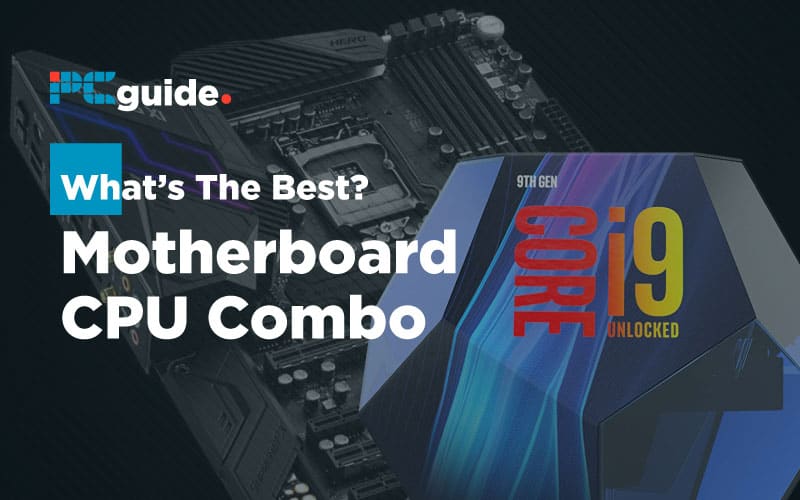Black Friday Is Live!
Check out all of the best deals across the web on our dedicated pages:
Best Black Friday Motherboard Deals
Best Black Friday CPU Deals
Best Black Friday AMD Deals
Best Black Friday Intel Deals
Best Black Friday Gaming PC Deals
It seems like the days when Intel reigned supreme in the CPU market are the tales of legend. Competition has been brewing in the PC market for some time now, but 2019 showed us that AMD was not only a worthy adversary for Team Blue, but they can also deliver a killing blow to their rivals in terms of value and raw performance. Now that a little time has passed since the major CPU releases of 2019, we can provide our readers with a confident breakdown of what the best CPU-mobo combos are for productivity and for gaming.
Whether you’re looking for a budget build, something value-oriented, or are planning on building a flagship battle station, we’ve covered your preferences in this comprehensive, detailed buyer’s guide. Keep on reading to see which 2020 CPU-Motherboard combo will best fit your particular needs.
Table of Contents
- 1. i9-9900K and ROG Maximus XI Hero Z390 Motherboard
- 2. Ryzen 9 3900x and MSI MEG X570 GODLIKE Motherboard
- 3. Intel i5-9600kf and Z390 Pro Carbon
- 4. Ryzen 5 3600 and ASUS AM4 TUF Gaming X570-Plus (Wi-Fi)
- 5. Ryzen 5 3400g and MSI Arsenal Gaming B450 Tomahawk Max
- Our Verdict: R5 3600 and R9 3900X are the best choices
1. i9-9900K and ROG Maximus XI Hero Z390 Motherboard
Starting off our list, in no particular order, is the flagship consumer CPU from Intel and the flagship Z390 chip motherboard from ASUS ROG. The two make a pair that’s bound to shred through every consumer-grade software, whether it’s meant for pleasure or business. Games, editing software, 3D renders, you’re going to run everything smoothly.
CPU Features:
- Coffee Lake
- 8 cores
- 16 threads
- 3.6 GHz base
- 5.0 GHz turbo
- 16 MB cache
- Intel UHD 630
- DDR4 2666 Hz
- 95-watt TDP
Motherboard Features:
- 1151 socket for 8/9 gen Intel chips
- 4 RAM DIMMs
- Up to 128 GB DDR4
- 3 x PCIe 3.0 x16
- 3 x PCIe 3.0 x1
- Preinstalled IO shield
- 4 x USB 3.1 Gen 2
- 2 x USB 3.1 Gen 1
- 2 x USB 2.0
- 1 x USB 3.1 Gen 2 front-panel connector
- 8-channel audio
- Wi-Fi 802.11 ac
- Solid VRM
The CPU is a beast. Factory unlocked, hitting 5 GHz as a base clock speed is quite common, just make sure you’re going to invest in an AIO cooler or a custom loop if you plan on running high overclocks. One of the few multithreaded chips from Intel, the 9900K is meant for enthusiasts who’re planning on throwing everything they can at this monster processor.
The ROG Maximus XI Z390 board pairs beautifully with the 9900k, providing a great VRM to reach stable overclocks at high frequencies. With a massive I/O and plenty of expansion slots, the Maximus allows you to run any configuration you want, and you probably want to take advantage of that. High-speed NVMe SSDs, support for Crossfire and SLI, there’s nothing you can’t do with this board.
Pros
- Enthusiast-grade
- Solid overclocking capabilities
- High clock speeds out of the box
Cons
- Expensive
- Only 8 cores and 16 MB of cache
2. Ryzen 9 3900x and MSI MEG X570 GODLIKE Motherboard
AMD hit it out of the park with their 3rd generation Ryzen chips, and it’s pretty easy to see why. At a competitive price, their flagship consumer-grade CPU, the 3900x, pulls no punches when facing the competition’s i9-9900K. Similar clock speeds, similar capabilities, but with 50% more cores and with much more cache, the Ryzen 9 3900x is nothing short of amazing. Just make sure to pick up the highest RAM frequency available to you, as the Zen 2 architecture really takes advantage of that.
CPU Features:
- Zen 2
- 12 cores
- 24 threads
- 3.8 base
- 4.6 turbo
- 64 MB cache
- DDR4 3200 Hz
- 105-watt TDP
Motherboard Features:
- AM4
- Support for 2nd and 3rd Gen Ryzen Processors
- 4 DIMMs
- Memory OC up to 4800+ MHz with Ryzen 3rd Gen Processors (not available on 2nd Gen Chips)
- 3 x M.2 Slots
- Up to 128 GB Memory
- RAID 0/1/10
- E-ATX Form Factor
When compared to the previous entry, this seems to be the better choice, the only downside being that Intel manages to get more single-core performance due to their slightly-higher clockspeeds. That being said, in multi-core intensive tasks, the 3900x is king. And don’t worry about the increased TDP, it still runs cooler than the 9900k based on benchmarks. Overall, this is the apex of consumer-grade CPU and motherboard combos, able to handle high-resolution, high refresh rate gaming, 8K video editing, and everything else you might want to run on it.
Pros
- Best performance on the market
- Highest core count
- Very efficient
- Gigantic L3 cache
Cons
- Single-threaded performance below 9900k
- Not an API, compared to the competition, although it’s expected that a build using a flagship CPU should be paired with a powerful GPU to prevent bottlenecking the system
3. Intel i5-9600kf and Z390 Pro Carbon
It’s pretty sad to see that Intel still doesn’t provide users with multithreaded chips across all their mid-range lineup. The intel i5-9600kf is a good choice if you’re planning on building a PC that’s aimed at gaming, but the lack of multithreading makes it less than suited for multitasking or productivity-related tasks. The 3.7 GHz base speed is great for gaming and will have even the most demanding titles running at butter-smooth framerates.
CPU Features:
- Coffee Lake
- 6 cores
- 6 threads
- 3.7 base
- 4.6 turbo
- 9 MB cache
- DDR4 2666 Hz
- 95-watt TDP
Motherboard Features:
- 1151 socket
- 4 RAM DIMMs
- 128 GB DDR4 up to 4400 Hz
- RAID 0/1/5/10
- 1 x USB 3.1 Gen 2 Type C
- 3 x USB 3.1 Gen 2 Type A
- 2 x USB 2.0
- SLI compatible
- Crossfire compatible
To be honest, this is an OK (at most), configuration. If you’re new to the PCmasterrace, then you should know that AMD has been dominating the mid-ranged CPU market for quite some time. This year, the 3rd generation chips really knocked things out of the park with increased power efficiency and better support for higher frequency RAM.
The i5-9600kf, on the other hand, is a single-threaded hexacore, and more and more applications come with support for multithreading, giving Ryzen chips a big edge in that particular aspect. Moreover, the slightly higher clockspeed doesn’t justify buying a mid-ranged i5 over an R5, so you should keep that in mind when shopping for your next build.
Pros
- Budget-friendly
- Good performance in most games
Cons
- Streaming and recording will have a big impact on performance
- Not very energy-efficient
- Not a great value
4. Ryzen 5 3600 and ASUS AM4 TUF Gaming X570-Plus (Wi-Fi)
The Ryzen 5 lineup has been a favorite since the first generation for the high-core counts, great overclocking capabilities, versatility, and very affordable price. The R5 3600 is a great, well-rounded CPU, capable of handling productivity tasks and AAA gaming with ease. Pair that with the ASUS X570 TUF Gaming motherboard, and you have a great base to build a future-proof rig without having to rob a bank.
CPU Features:
- Zen 2
- 6 cores
- 12 threads
- 3.2 GHz base
- 4.2 GHz turbo
- 32 MB cache
- DDR4 3200 Hz
- 65-watt TDP
Motherboard Features:
- 4 RAM DIMMs
- Up to 128 GB DDR4
- Up to 4400 MHz with OC modes
- 4 x USB 3.2 Gen 1
- 2 x USB 2.0
- 3 x USB 3.2 Gen 2 Type A
- 1 x USB 3.1 Gen 2 Type C
- Bios flash
- ATX Form Factor
- AuraSync-compatible
- Dual-Channel Support
- 8-channel Audio
- 2 x M.2 Socket 3
This is a very balanced foundation for any sort of consumer-grade build. Sure, you won’t be breaking any records, but as of late 2019, you can run any software using the R5 3600 with no hitches. The beauty of R5 processors is their value, and having a hexacore that’s unlocked, paired with a board that’s rocking a solid VRM means that you can even hit 4.2 GHz stable frequencies on your overclock. Ryzen is a very power-efficient chip and you’re bound to shred through any AAA games if you pair it with a decent GPU, maybe a 2060 or a 1070 Ti (if you can still find one).
Pros
- The best value
- Can run any software on a decent budget
- Very power-efficient
Cons
- CPU-intensive tasks like encoding might take longer
- Can’t stream at 60 fps without overheating
5. Ryzen 5 3400g and MSI Arsenal Gaming B450 Tomahawk Max
Where intel failed, AMD succeeded beautifully. Their integrated graphics outperform those from Team Blue, giving you budget builders pocket-friendly options that can still play hardball with the big boys. The R5 3400g processor can run AAA games and playable framerates provided you’re willing to compromise on visual fidelity and can run most competitive titles (League of Legends, Overwatch, DOTA2, Fortnite) at smooth and stable FPS, giving you the hardware you need to score in the online arenas. Even PUBG runs around 60 fps, a title that’s known for being particularly demanding in terms of GPU. Just make sure you have 16+ gigs of DDR4, as the APU does use DRAM as VRAM when running 3D software.
CPU Features:
- Zen 2
- 4 cores
- 8 threads
- 3.7 GHz base
- 4.2 GHz boost
- 6 MB cache
- DDR4 2933 Hz
- 65-watt TDP
Motherboard Features:
- 4 RAM DIMMs
- Up to 64 GB of DDR4 4133 Hz
- 1 x M.2 slots
- Supports 2-way Crossfire
- USB 3.2 and 3.1
- 2 x USB 2.0
So, the 3400g isn’t the most amazing processor, but it gets the job done. The B450 Tomahawk, on the other hand, is a great board that has some enthusiast features and comes with a pretty attractive price. You can start small and upgrade in the future, especially since you can run all 3rd Gen Ryzen processors up to R9 chips on it. If you’re planning on running buying a GPU, then the better choice is an R5 3600, but if you wanna go budget gaming all the way, this puppy will have you running competitive titles at very playable framerates.
Pros
- Great price-value ratio
- Can run a lot of modern titles even if it’s a budget build
- Good for future upgrades
Cons
- Not the best performance
- The APU further hinders the PC performance because it allocates other resources
Our Verdict: R5 3600 and R9 3900X are the best choices
There aren’t really any bad choices here (unless maybe the i5). On one hand, the R5 reigns as king of value, while the 3900x dominates in terms of performance. Pair either one with their respective motherboards, watch some tutorials on overclocking, and fit your DIMMs with some high-speed RAM modules, and you’re bound to create a station that’s going to master any software you throw at it.

